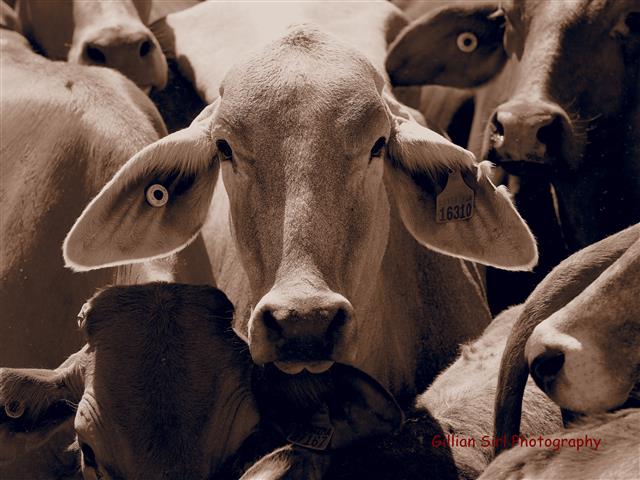Pressure and release
Host: Liveringa Station
Written by Jed O’Brien – Manager, Liveringa Station.
Jed and I are in our sixth year here at Liveringa Station – and finally I think we can now say we know both the place and the job really well. Jed agreed to start our week of blogs with a piece on his personal philosophy . . .
– Karen
It’s all about keeping things low stress; it’s vital to the operation. Calm cows, horses, and people. It’s a simple principle, you apply pressure to get some movement and release the pressure after the desired response. That’s how we get cattle through the yard, horses through a turn, and ringers through the year. Pressure and release.
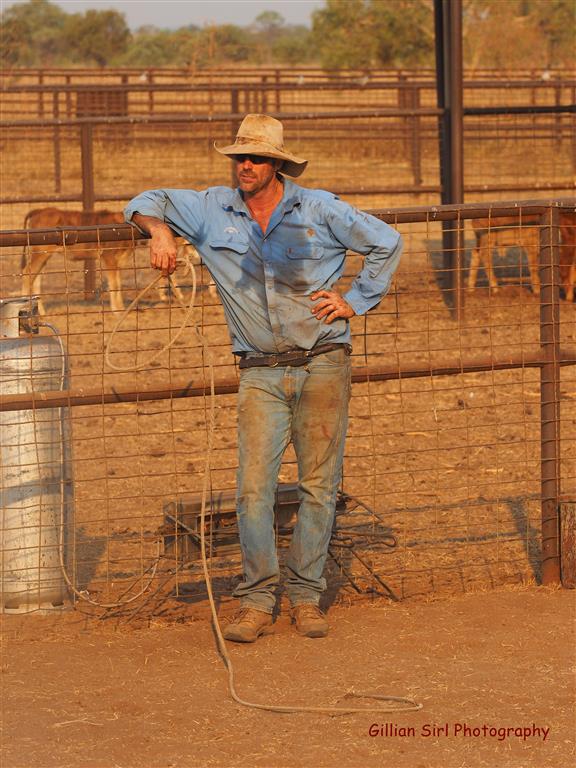 Jed pictured above (looking pretty calm and non-stressed!).
Jed pictured above (looking pretty calm and non-stressed!).
The way we work cattle at Liveringa is taken very seriously. New staff are inducted to the low stress stock handling principles each year and we talk about it all the time through the year (well I do, ad nauseam I suspect). Every year for the past six years Jim Lindsay has been invited to teach and reinforce the methods and principles of low stress stock handling.
The cattle handling stuff is bit of old school in many ways, stuff that may have been lost over the years due to the transient nature of our industry. Jim puts in a modern take, a few new ideas and a fair bit of animal psychology. I won’t go into all the principles but one is important to this piece; I can apply it in the running of the whole business, not just the cows. Pressure and release.
We apply pressure to a cow or a mob to get it to move somewhere, and the pressure is released when they move in the desired direction. Generally the pressure comes in the form of simply being in a cow’s personal space (or flight zone). It’s a bit like that weird and annoying guy at the bar, that stands so close that you need to keep moving away. Well that’s me in the back yard with the cows, moving them away. Perhaps we’re all a bit weird and annoying over here at Liveringa . . .
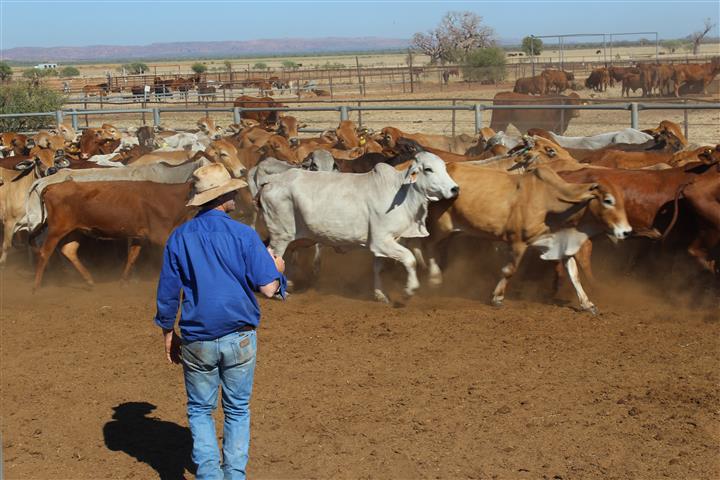 Jed in the “back yard” moving the cattle off pressure.
Jed in the “back yard” moving the cattle off pressure.
If done properly you end up with a method of moving cattle without sticks and whips, without noise and frustration, without getting cattle and people stressed and injured.
Ok, so we don’t get it right all the time, we’re not perfect. There are times when the cattle do get stirred up and we need to quickly climb, or get lifted, over the fence. There are 20 thousand cows on Liveringa and there’s gotta be a few that woke up on the wrong side of the boab.
But we keep trying. We learn and use these stock handling techniques because we care for the cows, we give a damn. We want to get the job done efficiently and safely; it’s important. Cattle that are under stress place people under stress (and vice versa).
Horses too can come to work in a bad mood, so it’s important to help staff enhance their riding ability, be kinder to, and get higher performance from the horses in the plant. We have had a number of horsemanship schools with staff over the years and there’s one or two old hands here as well that can assist the ringers along the way.
Riding a horse is a bit like moving a cow. You apply pressure or discomfort to ask it to do something and release the pressure as a reward for doing it. Although don’t try this technique on the back of a cow as it seldom works . . .
We still have the odd worker’s compensation claim through horse riding accidents so we haven’t got this 100% yet either. But getting a buster from a horse gives a young ringer something to brag about at the bar, and that’s important too.
There is a difference between pressure and stress. Stress is pressure with no way out or no foreseeable release. Pressure needs to be released before it becomes stress. That release can come in different ways; for the cow it can be an open gate, for the horse it’s one step sideways, and for the ringer it’s the rodeo in two weeks’ time.
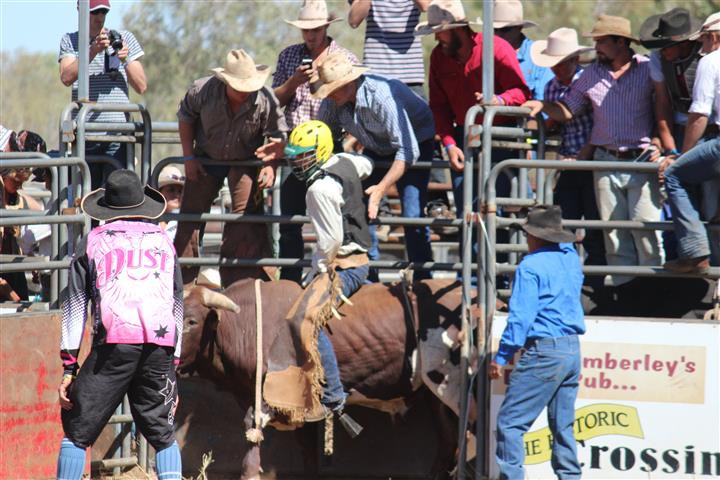 One of our ringers riding a bull at a rodeo last year.
One of our ringers riding a bull at a rodeo last year.
Now let’s put some pressure on the people. The speed at which we can do the first weaning round is vital to productivity of the station. Weaning the calves takes the nutritional pressure away from the cows. This improves reproduction rates and reduces cow mortality. Increasing breeder nutrition, or holding their condition, through the long dry season is our greatest challenge and weaning is our greatest tool. We start weaning round one in April and work paddock by paddock until we finish in July.
The stock camp has been working flat out since April. If we are to take time off work between April and July it is under sufferance from me as there is always something more to do or get done. While often difficult to achieve, it is important that the odd day off is forthcoming. It’s a low stress principle, “when pressure is applied it must be released”. So we need to take some time to release the pressure and have a bit of fun along the way.
In the past we have held various events at and through our social club. Events like quiz nights (well that was a pretty short party), “Liveringa has Talent” (we all got to bed early that night too), mini olympics, and the odd birthday party. Flyboarding is one of the latest crazes to hit the country and last year we got in on that craze. Yep, Liveringa, too cool for school. The jet ski arrived on the dam 10km from the homestead and the jet boots were strapped on. Everyone got to have a go at flying and had a heap of fun. Although the cows and crocs were a bit annoyed with us turning their social gathering place into a theme park.
 Karen having her turn at flyboarding at Erskine’s dam in 2014.
Karen having her turn at flyboarding at Erskine’s dam in 2014.
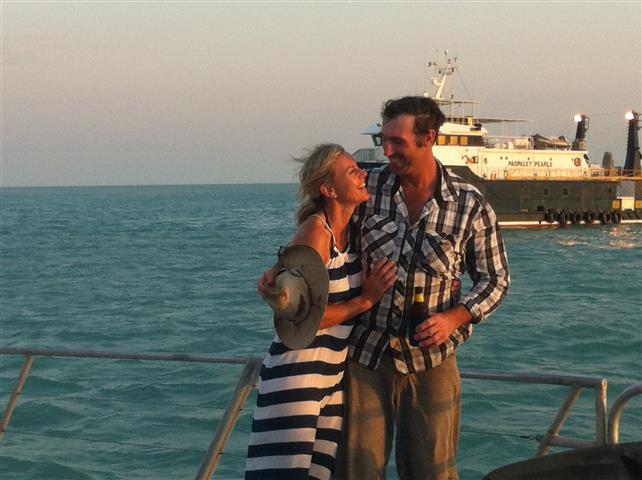 Jed and Karen on our ‘Liveringa end of season sunset cruise’ in Broome (despite the fact that it looks like only the two of us were on board – the whole Liveringa team was there!).
Jed and Karen on our ‘Liveringa end of season sunset cruise’ in Broome (despite the fact that it looks like only the two of us were on board – the whole Liveringa team was there!).
Through July and August I find myself organising the work program around rodeos and race meetings. This weekend is the annual Derby campdraft and rodeo. Into the truck we load the best horses, swags, some tucker, and the town hats. This weekend we test our skills on the campdraft, rodeo, and dance arena. The team has a great time at the drafts and rodeos and we will go to three or four through the year. They can get off the station, let their hair down, drink some beer, and catch up and fraternize with ringers and jillaroos from other stations.
July through August is the Broome race carnival and for the next few weeks it’s the humble fascinator that will be dictating to Liveringa’s mustering program. This week “it’s Ladies Day” and Karen will need to spend two nights in Broome to get ready for and over it. What’s worse is that she is taking Cath, the governess with her. So I will be under a bit of pressure, with little release, looking after our four kids for three days.
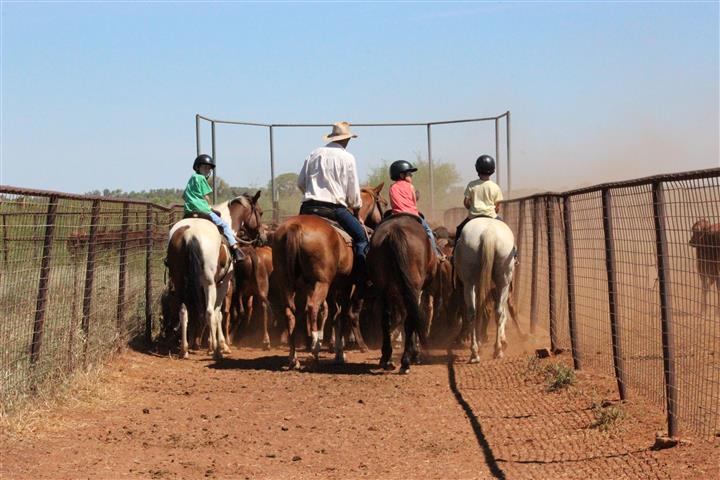 Jed working in the feedlot with the three boys.
Jed working in the feedlot with the three boys.
Next week is the Broome cup and the entire team will be going to that one. Karen has a good friend in Broome that designs and makes head pieces or fascinators. You know the kind that matches your shoes and handbag but offers little shade to your face? Well apparently she is very good at it and is taking her wares to the New York fashion show in September. “Great” I thought when I heard about it, “Oh Shit” was next when Karen told me she was going too. Well I guess a trip to NY is a great opportunity for some well-earned release from six years of pressure at Liveringa. Ten days with the kids though, I’m pleased she’s not taking the govie to this one. That much pressure on management should be a sackable offence for both of them.
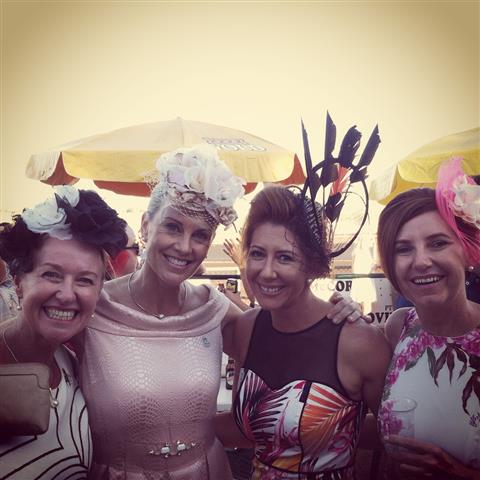 Karen with friends at the Kimberley Cup earlier this year.
Karen with friends at the Kimberley Cup earlier this year.
But let’s not get too carried away with how much “socializing” we do at Liveringa.
The staff at Liveringa work pretty damn hard; they love the job (well they all said so this week on Central Station) and their commitment doesn’t go unnoticed or unappreciated. Taking time out for socializing allows them to enjoy a different side to their job in the Kimberley and life on the station. A contented team has a healthy balance of pressure and release. That’s important to me as a Manager – we need to look after these guys, I want them to come back next year!

